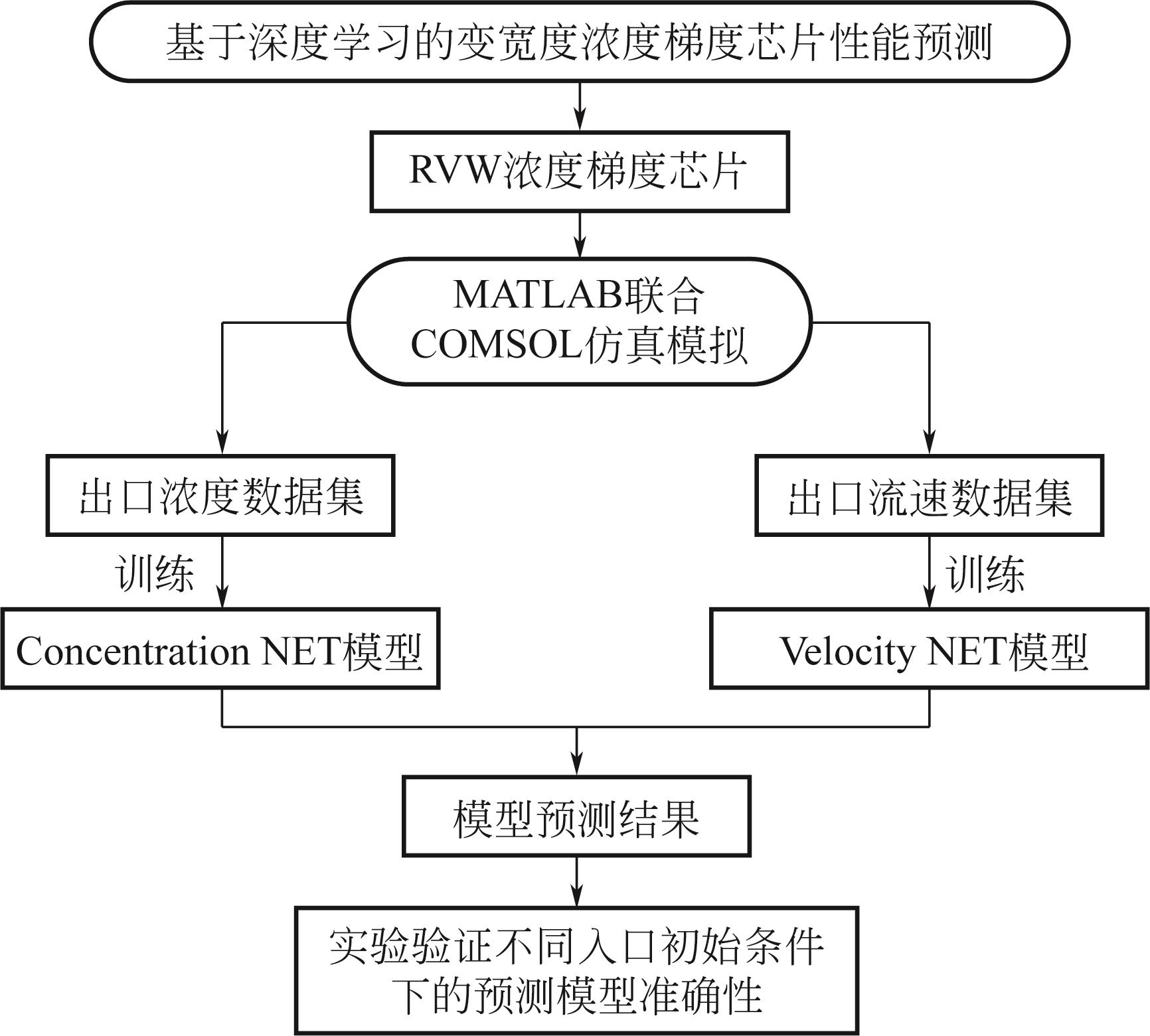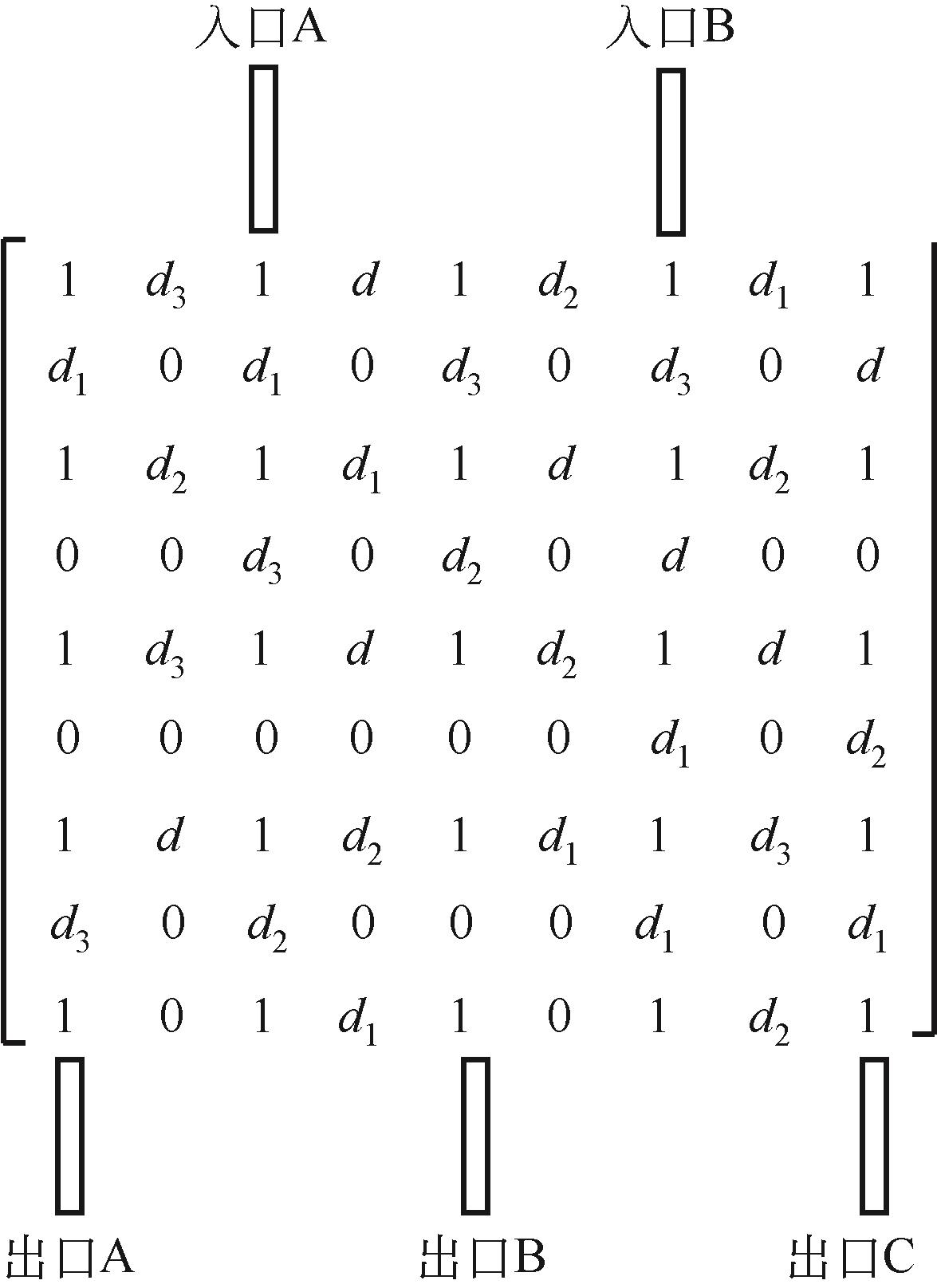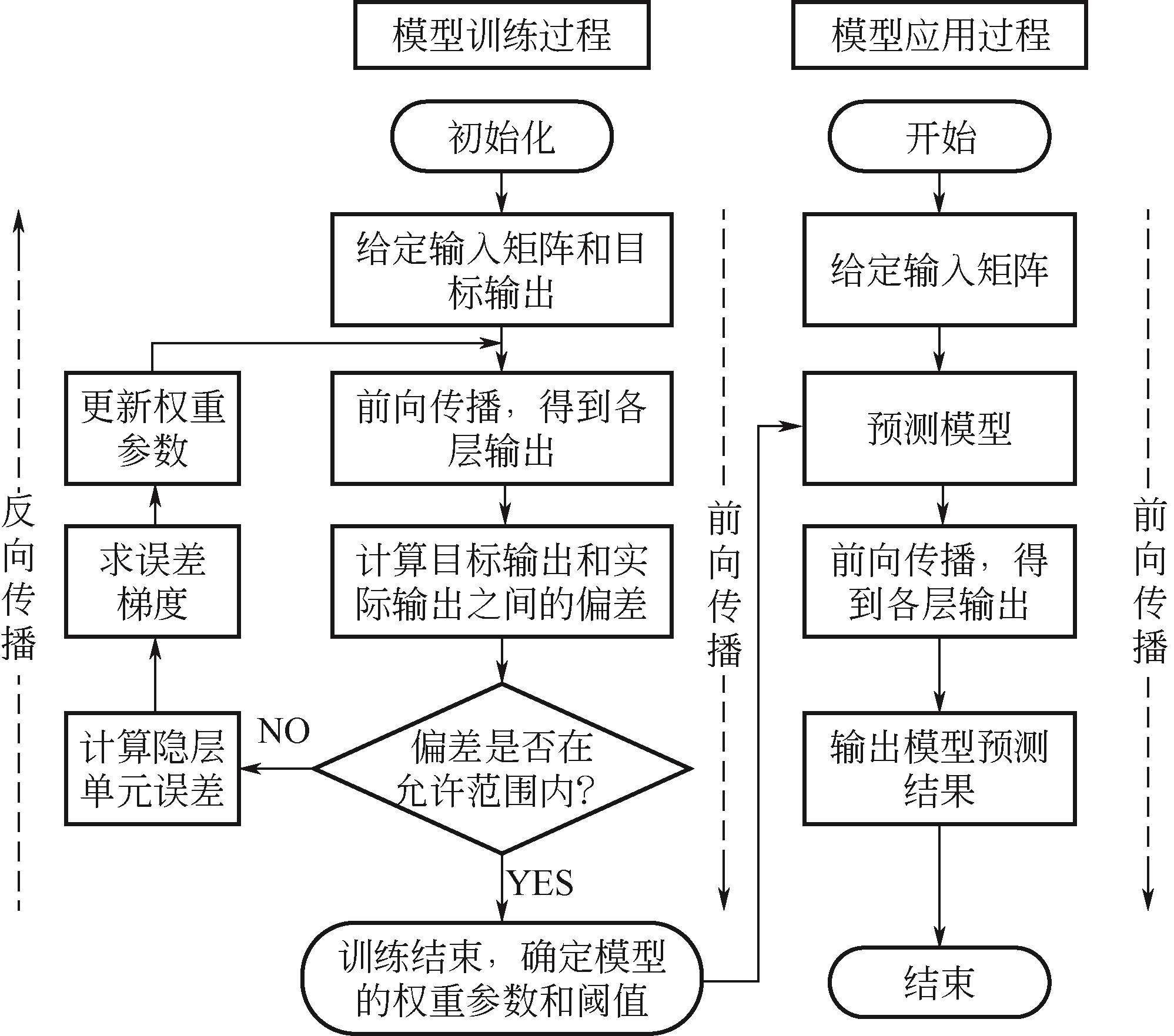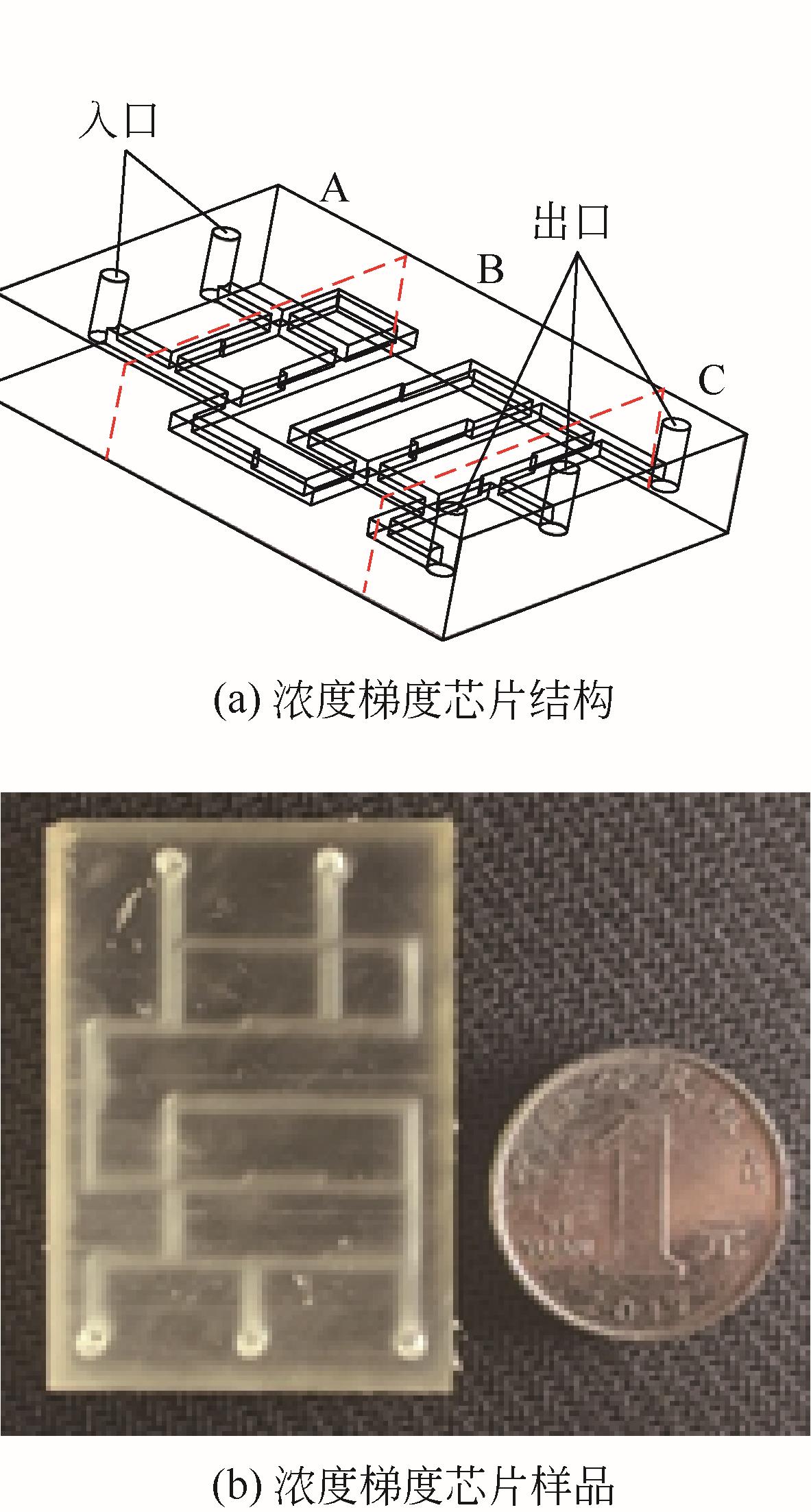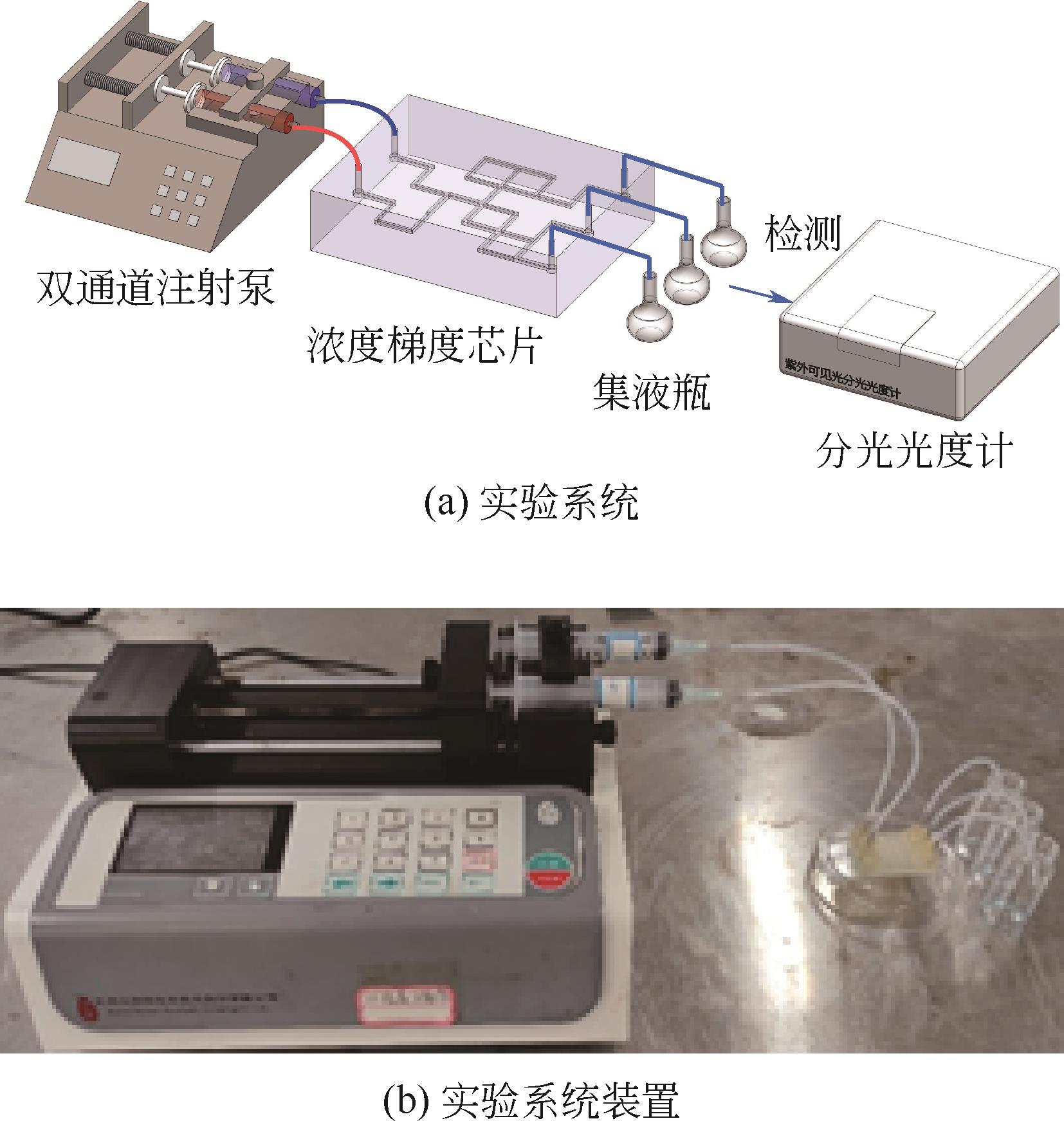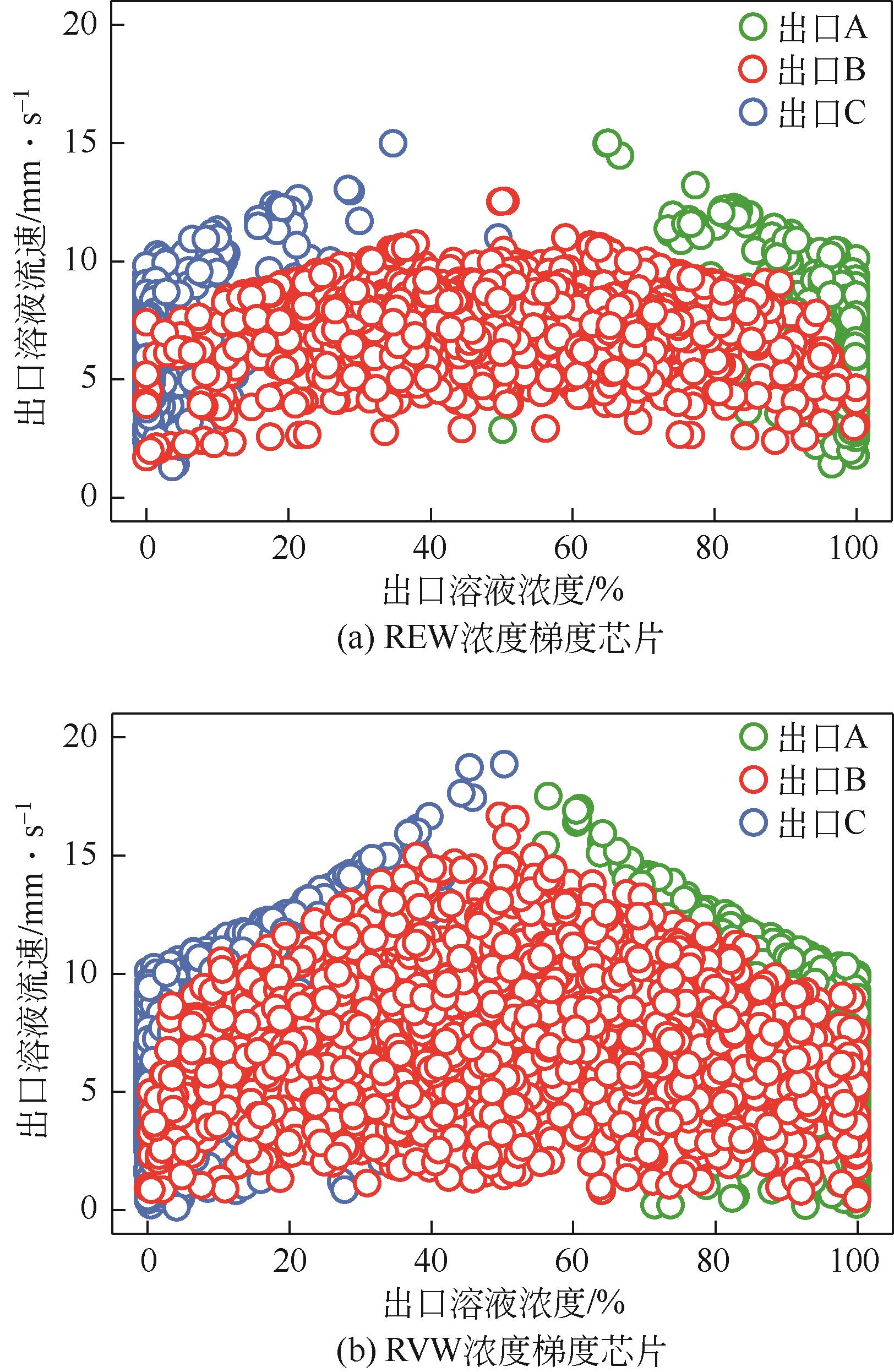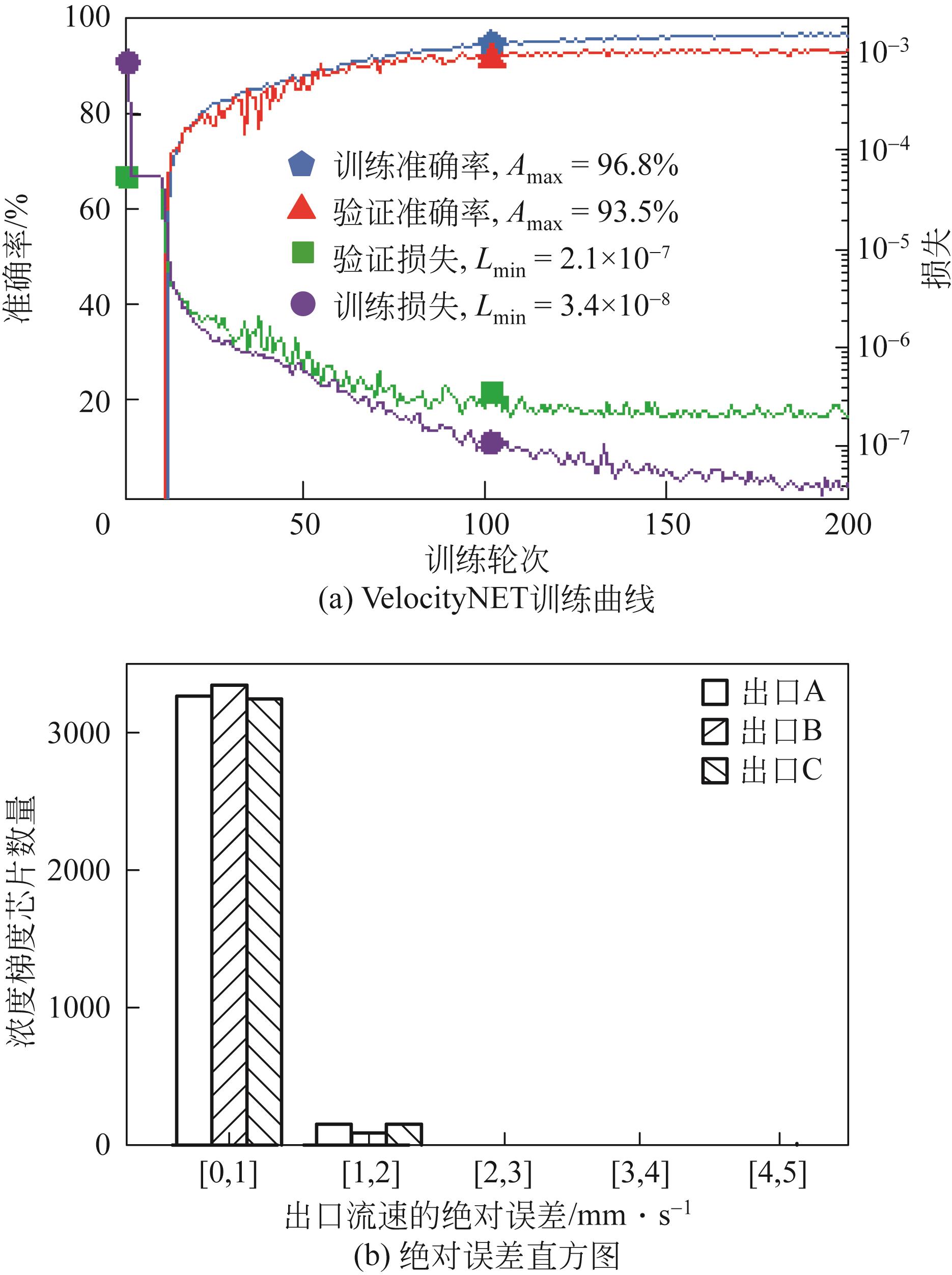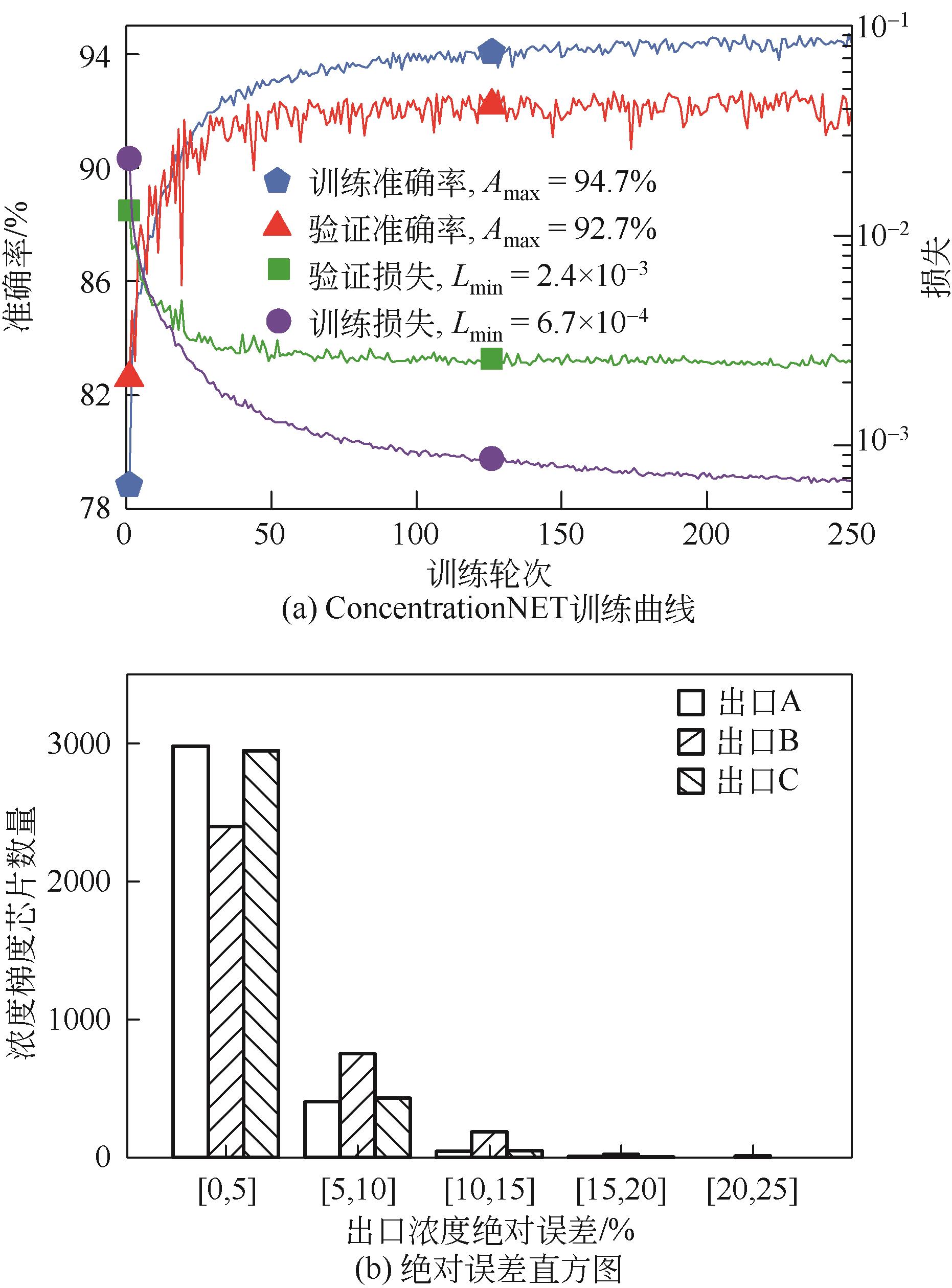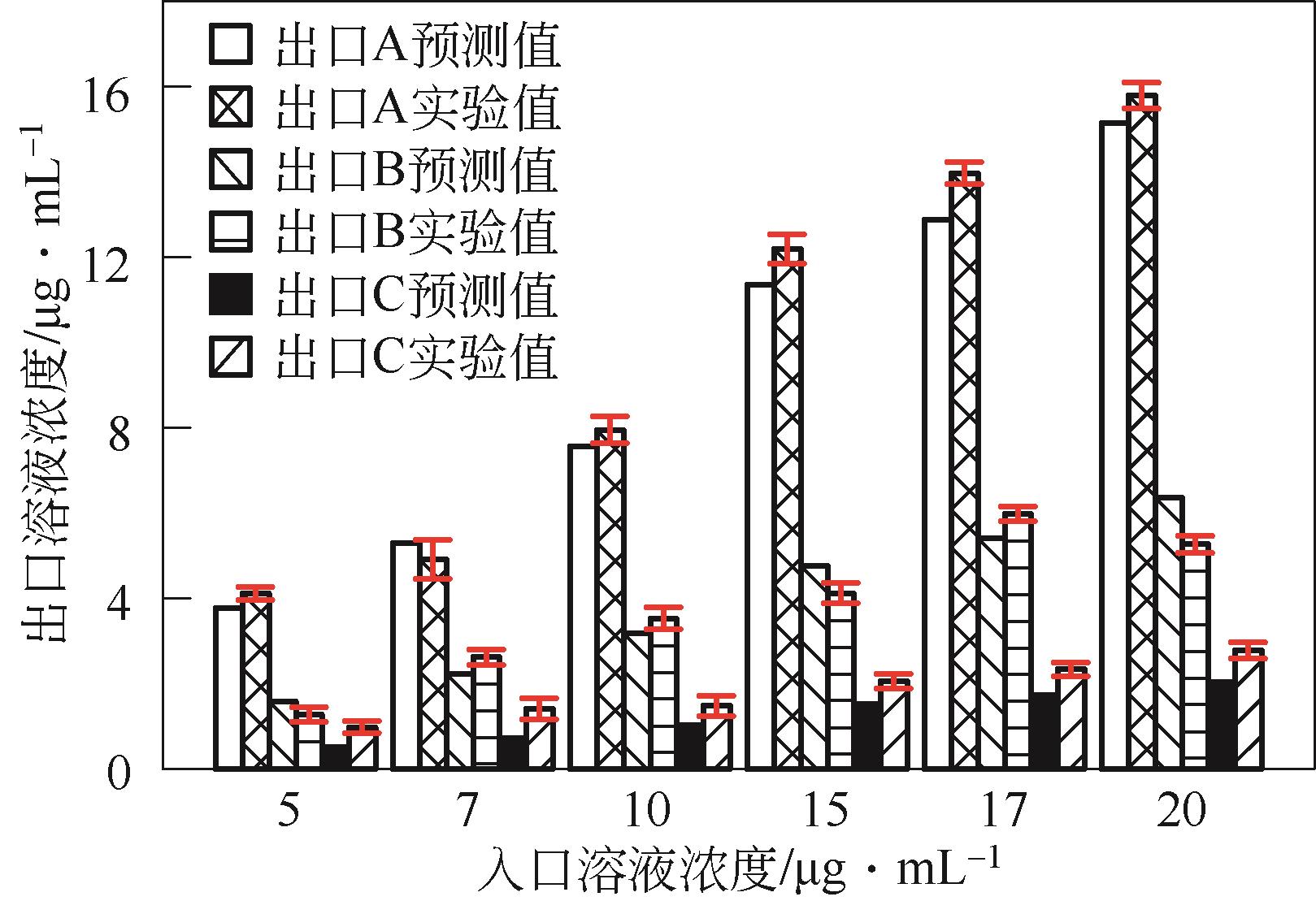Chemical Industry and Engineering Progress ›› 2023, Vol. 42 ›› Issue (7): 3383-3393.DOI: 10.16085/j.issn.1000-6613.2022-1839
• Column: Intelligent chemical equipment and safety • Previous Articles Next Articles
Performance prediction of variable-width microfluidic concentration gradient chips by deep learning
YU Junnan1,2( ), YU Jianfeng1,2(
), YU Jianfeng1,2( ), CHENG Yang1,2, QI Yibo1,2, HUA Chunjian1,2, JIANG Yi1,2
), CHENG Yang1,2, QI Yibo1,2, HUA Chunjian1,2, JIANG Yi1,2
- 1.School of Mechanical Engineering, Jiangnan University, Wuxi 214122, Jiangsu, China
2.Jiangsu Key Laboratory of Food Manufacturing Equipment and Technology, Wuxi, 214122, Jiangsu, China
-
Received:2022-10-08Revised:2022-11-24Online:2023-08-14Published:2023-07-15 -
Contact:YU Jianfeng
基于深度学习的变宽度浓度梯度芯片性能预测
俞俊楠1,2( ), 俞建峰1,2(
), 俞建峰1,2( ), 程洋1,2, 齐一搏1,2, 化春键1,2, 蒋毅1,2
), 程洋1,2, 齐一搏1,2, 化春键1,2, 蒋毅1,2
- 1.江南大学机械工程学院,江苏 无锡 214122
2.江苏省食品先进制造装备技术重点实验室,江苏 无锡 214122
-
通讯作者:俞建峰 -
作者简介:俞俊楠(1997—),男,硕士研究生,研究方向为微流控技术与深度学习算法。E-mail:jun2016yjn@163.com。 -
基金资助:江苏省先进食品制造装备与技术重点实验室(FMZ-202016)
CLC Number:
Cite this article
YU Junnan, YU Jianfeng, CHENG Yang, QI Yibo, HUA Chunjian, JIANG Yi. Performance prediction of variable-width microfluidic concentration gradient chips by deep learning[J]. Chemical Industry and Engineering Progress, 2023, 42(7): 3383-3393.
俞俊楠, 俞建峰, 程洋, 齐一搏, 化春键, 蒋毅. 基于深度学习的变宽度浓度梯度芯片性能预测[J]. 化工进展, 2023, 42(7): 3383-3393.
share this article
Add to citation manager EndNote|Ris|BibTeX
URL: https://hgjz.cip.com.cn/EN/10.16085/j.issn.1000-6613.2022-1839
| 模拟参数 | 数值 |
|---|---|
| 流体密度ρ/kg·m-3 | 103 |
| 流体动力黏度μ/Pa·s-1 | 10-3 |
| 分子扩散系数D/m2·s-1 | 10-9 |
| 出口压力p/Pa | 0 |
| 壁面流速u/m·s-1 | 0 |
| 模拟参数 | 数值 |
|---|---|
| 流体密度ρ/kg·m-3 | 103 |
| 流体动力黏度μ/Pa·s-1 | 10-3 |
| 分子扩散系数D/m2·s-1 | 10-9 |
| 出口压力p/Pa | 0 |
| 壁面流速u/m·s-1 | 0 |
| 阶段 | 类型 | 卷积核尺寸 | 输出通道数 |
|---|---|---|---|
| 阶段一 | Conv1 | 3×3 | 64 |
| Conv2 | 3×3 | 64 | |
| 阶段二 | Conv3 | 3×3 | 128 |
| Conv4 | 3×3 | 128 | |
| 阶段三 | FC1 | — | 128 |
| FC2 | — | 3或2① |
| 阶段 | 类型 | 卷积核尺寸 | 输出通道数 |
|---|---|---|---|
| 阶段一 | Conv1 | 3×3 | 64 |
| Conv2 | 3×3 | 64 | |
| 阶段二 | Conv3 | 3×3 | 128 |
| Conv4 | 3×3 | 128 | |
| 阶段三 | FC1 | — | 128 |
| FC2 | — | 3或2① |
| 阶段 | 类型 | 卷积核尺寸 | 输出通道数 |
|---|---|---|---|
| 阶段一 | Conv1 | 3×3 | 32 |
| Conv2~Conv9 | 2×2 | 32 | |
| 阶段二 | Conv10 | 3×3 | 64 |
| Conv11~Conv12 | 2×2 | 64 | |
| 阶段三 | FC1 | — | 64 |
| FC2 | — | 3或2① |
| 阶段 | 类型 | 卷积核尺寸 | 输出通道数 |
|---|---|---|---|
| 阶段一 | Conv1 | 3×3 | 32 |
| Conv2~Conv9 | 2×2 | 32 | |
| 阶段二 | Conv10 | 3×3 | 64 |
| Conv11~Conv12 | 2×2 | 64 | |
| 阶段三 | FC1 | — | 64 |
| FC2 | — | 3或2① |
| 试剂 | 化学式 | 生产厂商 |
|---|---|---|
| 亚甲基蓝 | C16H18ClN₃S | 飞净科研 |
| 双氧水 | H2O2 | 国药集团 |
| 浓硫酸 | H2SO4 | 国药集团 |
| 试剂 | 化学式 | 生产厂商 |
|---|---|---|
| 亚甲基蓝 | C16H18ClN₃S | 飞净科研 |
| 双氧水 | H2O2 | 国药集团 |
| 浓硫酸 | H2SO4 | 国药集团 |
| 设备名称 | 设备型号/尺寸 | 生产厂商 |
|---|---|---|
| 计算机 | R7000 | 联想 |
| 双通道注射泵 | WH-SP-02 | 汶颢微流控 |
| 微量进样器 | — | 美国BD |
| 聚四氟乙烯导管 | — | 淘宝商城 |
| 微流控钢针 | — | 淘宝商城 |
| 浓度梯度芯片 | RVW-1 | 自制 |
| 分光光度计 | UV-1800 | 日本岛津 |
| 移液器 | DGYD100~1000 | 大龙兴创 |
| DGYD1000~5000 |
| 设备名称 | 设备型号/尺寸 | 生产厂商 |
|---|---|---|
| 计算机 | R7000 | 联想 |
| 双通道注射泵 | WH-SP-02 | 汶颢微流控 |
| 微量进样器 | — | 美国BD |
| 聚四氟乙烯导管 | — | 淘宝商城 |
| 微流控钢针 | — | 淘宝商城 |
| 浓度梯度芯片 | RVW-1 | 自制 |
| 分光光度计 | UV-1800 | 日本岛津 |
| 移液器 | DGYD100~1000 | 大龙兴创 |
| DGYD1000~5000 |
| 1 | GOETZ L H, SCHORK N J. Personalized medicine: Motivation, challenges, and progress[J]. Fertility and Sterility, 2018, 109(6): 952-963. |
| 2 | VAZ V M, KUMAR L. 3D printing as a promising tool in personalized medicine[J]. AAPS PharmSciTech, 2021, 22(1): 1-20. |
| 3 | WYATT SHIELDS IV C, REYES C D, LÓPEZ G P. Microfluidic cell sorting: A review of the advances in the separation of cells from debulking to rare cell isolation[J]. Lab on a Chip, 2015, 15(5): 1230-1249. |
| 4 | CHI Chunwei, AHMED A H R, DERELI-KORKUT Z, et al. Microfluidic cell chips for high-throughput drug screening[J]. Bioanalysis, 2016, 8(9): 921-937. |
| 5 | ZHANG Shuyuan, LIANG Xiao, HUANG Xinye, et al. Precise and fast microdroplet size distribution measurement using deep learning[J]. Chemical Engineering Science, 2022, 247: 116926. |
| 6 | GOŁĄB M, WOZNIAKIEWICZ M, NOWAK P M, et al. An automated hydrodynamically mediated technique for preparation of calibration solutions via capillary electrophoresis system as a promising alternative to manual pipetting[J]. Molecules (Basel, Switzerland), 2021, 26(20): 6268. |
| 7 | FLEISCHER H, BAUMANN D, JOSHI S, et al. Analytical measurements and efficient process generation using a dual-arm robot equipped with electronic pipettes[J]. Energies, 2018, 11(10): 2567. |
| 8 | CAI Gaozhe, XUE Li, ZHANG Huilin, et al. A review on micromixers[J]. Micromachines, 2017, 8(9): 274. |
| 9 | 王炳捷, 李辉, 杨晓勇, 等. CFD数值模拟技术在液滴微流控多相流特性研究的应用进展[J]. 化工进展, 2021, 40(4): 1715-1735. |
| WANG Bingjie, LI Hui, YANG Xiaoyong, et al. Application process of CFD-numerical simulation technology for multiphase flow characteristics study in droplet-microfluidic systems[J]. Chemical Industry and Engineering Progress, 2021, 40(4): 1715-1735. | |
| 10 | CHANG Bo, KIVINEN O, PINI I, et al. Nanoliter deposition on star-shaped hydrophilic-superhydrophobic patterned surfaces[J]. Soft Matter, 2018, 14(36): 7500-7506. |
| 11 | ELVIRA K S, XAVIER CASADEVALL I S, WOOTTON R C R, et al. The past, present and potential for microfluidic reactor technology in chemical synthesis[J]. Nature Chemistry, 2013, 5(11): 905-915. |
| 12 | BEIN A, SHIN Woojung, JALILI-FIROOZINEZHAD S, et al. Microfluidic organ-on-a-chip models of human intestine[J]. Cellular and Molecular Gastroenterology and Hepatology, 2018, 5(4): 659-668. |
| 13 | LEE Sanghyun, KIM Hojin, LEE Wonhyung, et al. Microfluidic-based cell handling devices for biochemical applications[J]. Journal of Micromechanics and Microengineering, 2018, 28(12): 123001. |
| 14 | GENG Chunyang, LI Chiyu, LI Wang, et al. A simple fabricated microfluidic chip for urine sample-based bladder cancer detection[J]. Journal of Micromechanics and Microengineering, 2018, 28(11): 115011. |
| 15 | LAXMI V, JOSHI S S, AGRAWAL A. Extracting white blood cells from blood on microfluidics platform: A review of isolation techniques and working mechanisms[J]. Journal of Micromechanics and Microengineering, 2022, 32(5): 053001. |
| 16 | WALKER G M, OZERS M S, BEEBE D J. Cell infection within a microfluidic device using virus gradients[J]. Sensors and Actuators B: Chemical, 2004, 98(2/3): 347-355. |
| 17 | SAAD M G, SELAHI A, ZOROMBA M S, et al. A droplet-based gradient microfluidic to monitor and evaluate the growth of Chlorella vulgaris under different levels of nitrogen and temperatures[J]. Algal Research, 2019, 44: 101657. |
| 18 | 关尧. 面向药物微球的浓度微液滴芯片的操控研究[D]. 杭州: 杭州电子科技大学, 2021. |
| GUAN Yao. Research on manipulation of concentration micro-droplet microfluidic chips for drug microspheres[D]. Hangzhou: Hangzhou Dianzi University, 2021. | |
| 19 | LASHKARIPOUR A, RODRIGUEZ C, MEHDIPOUR N, et al. Machine learning enables design automation of microfluidic flow-focusing droplet generation[J]. Nature Communications, 2021, 12(1): 1-14. |
| 20 | LASHKARIPOUR A, GOHARIMANESH M, ABOUEI MEHRIZI A, et al. An adaptive neural-fuzzy approach for microfluidic droplet size prediction[J]. Microelectronics Journal, 2018, 78: 73-80. |
| 21 | 杨文宇, 谢应明, 闫坤, 等. 基于灰色关联BP神经网络的压缩式蓄冷系统中的水合物生成量预测[J]. 化工进展, 2021, 40(2): 664-670. |
| YANG Wenyu, XIE Yingming, YAN Kun, et al. Prediction of hydrate production in compressive cold storage system based on grey relational BP neural network[J]. Chemical Industry and Engineering Progress, 2021, 40(2): 664-670. | |
| 22 | RAWAT W, WANG Zenghui. Deep convolutional neural networks for image classification: A comprehensive review[J]. Neural Computation, 2017, 29(9): 2352-2449. |
| 23 | KRIZHEVSKY A, SUTSKEVER I, HINTON G E. ImageNet classification with deep convolutional neural networks[J]. Communications of the ACM, 2017, 60(6): 84-90. |
| 24 | WANG Junchao, BRISK P, GROVER W H. Random design of microfluidics[J]. Lab on a Chip, 2016, 16(21): 4212-4219. |
| 25 | JI Weiqing, Tsung Yi HO, WANG Junchao, et al. Microfluidic design for concentration gradient generation using artificial neural network[J]. IEEE Transactions on Computer: Aided Design of Integrated Circuits and Systems, 2020, 39(10): 2544-2557. |
| 26 | WANG Junchao, ZHANG Naiyin, CHEN Jinkai, et al. Predicting the fluid behavior of random microfluidic mixers using convolutional neural networks[J]. Lab on a Chip, 2021, 21(2): 296-309. |
| 27 | ROSEBROCK A. Deep learning for computer vision with python[M]. Midtown Manhattan: W. W. Norton & Company, 2017: 229-238. |
| 28 | SZEGEDY C, VANHOUCKE V, IOFFE S, et al. Rethinking the inception architecture for computer vision[C]// 2016 IEEE Conference on Computer Vision and Pattern Recognition. IEEE, 2016: 2818-2826. |
| [1] | WANG Tai, SU Shuo, LI Shengrui, MA Xiaolong, LIU Chuntao. Dynamic behavior of single bubble attached to the solid wall in the AC electric field [J]. Chemical Industry and Engineering Progress, 2023, 42(S1): 133-141. |
| [2] | ZHAO Chen, MIAO Tianze, ZHANG Chaoyang, HONG Fangjun, WANG Dahai. Heat transfer characteristics of ethylene glycol aqueous solution in slit channel under negative pressure [J]. Chemical Industry and Engineering Progress, 2023, 42(S1): 148-157. |
| [3] | XU Chenyang, DU Jian, ZHANG Lei. Chemical reaction evaluation based on graph network [J]. Chemical Industry and Engineering Progress, 2023, 42(S1): 205-212. |
| [4] | CHEN Kuangyin, LI Ruilan, TONG Yang, SHEN Jianhua. Structure design of gas diffusion layer in proton exchange membrane fuel cell [J]. Chemical Industry and Engineering Progress, 2023, 42(S1): 246-259. |
| [5] | YANG Yudi, LI Wentao, QIAN Yongkang, HUI Junhong. Analysis of influencing factors of natural gas turbulent diffusion flame length in industrial combustion chamber [J]. Chemical Industry and Engineering Progress, 2023, 42(S1): 267-275. |
| [6] | GUO Qiang, ZHAO Wenkai, XIAO Yonghou. Numerical simulation of enhancing fluid perturbation to improve separation of dimethyl sulfide/nitrogen via pressure swing adsorption [J]. Chemical Industry and Engineering Progress, 2023, 42(S1): 64-72. |
| [7] | SHAO Boshi, TAN Hongbo. Simulation on the enhancement of cryogenic removal of volatile organic compounds by sawtooth plate [J]. Chemical Industry and Engineering Progress, 2023, 42(S1): 84-93. |
| [8] | ZHAO Xi, MA Haoran, LI Ping, HUANG Ailing. Simulation analysis and optimization design of mixing performance of staggered impact micromixer [J]. Chemical Industry and Engineering Progress, 2023, 42(9): 4559-4572. |
| [9] | LIU Xuanlin, WANG Yikai, DAI Suzhou, YIN Yonggao. Analysis and optimization of decomposition reactor based on ammonium carbamate in heat pump [J]. Chemical Industry and Engineering Progress, 2023, 42(9): 4522-4530. |
| [10] | CHEN Lin, XU Peiyuan, ZHANG Xiaohui, CHEN Jie, XU Zhenjun, CHEN Jiaxiang, MI Xiaoguang, FENG Yongchang, MEI Deqing. Investigation on the LNG mixed refrigerant flow and heat transfer characteristics in coil-wounded heat exchanger (CWHE) system [J]. Chemical Industry and Engineering Progress, 2023, 42(9): 4496-4503. |
| [11] | YE Zhendong, LIU Han, LYU Jing, ZHANG Yaning, LIU Hongzhi. Optimization of thermochemical energy storage reactor based on calcium and magnesium binary salt hydrates [J]. Chemical Industry and Engineering Progress, 2023, 42(8): 4307-4314. |
| [12] | SHAN Xueying, ZHANG Meng, ZHANG Jiafu, LI Lingyu, SONG Yan, LI Jinchun. Numerical simulation of combustion of flame retardant epoxy resin [J]. Chemical Industry and Engineering Progress, 2023, 42(7): 3413-3419. |
| [13] | WANG Shuo, ZHANG Yaxin, ZHU Botao. Prediction of erosion life of coal water slurry pipeline based on grey prediction model [J]. Chemical Industry and Engineering Progress, 2023, 42(7): 3431-3442. |
| [14] | ZHOU Longda, ZHAO Lixin, XU Baorui, ZHANG Shuang, LIU Lin. Advances in electrostatic-cyclonic coupling enhanced multiphase media separation research [J]. Chemical Industry and Engineering Progress, 2023, 42(7): 3443-3456. |
| [15] | CHEN Weiyang, SONG Xin, YIN Yaran, ZHANG Xianming, ZHU Chunying, FU Taotao, MA Youguang. Effect of liquid viscosity on bubble interface in the rectangular microchannel [J]. Chemical Industry and Engineering Progress, 2023, 42(7): 3468-3477. |
| Viewed | ||||||
|
Full text |
|
|||||
|
Abstract |
|
|||||

